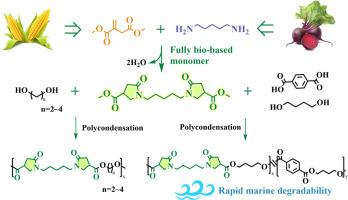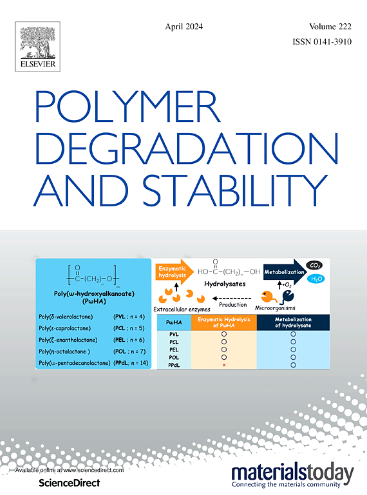以全生物基二酯为基础合成可再生和海水降解聚酯
IF 6.3
2区 化学
Q1 POLYMER SCIENCE
引用次数: 0
摘要
设计和开发可在海水中降解的生物基塑料是解决化石塑料对海水污染的一种潜在方法。本文以可再生的 1,5-戊二胺和衣康酸二甲酯为原料,合成了 N,N'-五亚甲基双(吡咯烷酮-4-甲基羧酸酯)(PBPC),这是一种具有两个吡咯烷酮环的生物基二酯。PBPC 与三个 α、ω-二元醇聚合,制备出生物基均聚酯,其数均分子量 (Mn) 约为 25 kDa。与聚乳酸(PLA)和聚丁二酸丁二醇酯(PBS)相比,这些无定形均聚酯具有显著的紫外线屏蔽能力。在人工海水中培养 150 天的实验表明,基于 PBPC 的均聚酯具有快速的海水降解性。然后,PBPC 与 1,4-丁二醇和对苯二甲酸共聚,制备出一系列 Mn 在 20 kDa 左右的共聚多酯。在聚对苯二甲酸丁二醇酯(PBT)中引入 PBPC 后,韧性和对海水降解的敏感性都得到了提高。根据 PBPC 成分的不同,共聚聚酯的热性能、机械性能和降解率都是可调的。总之,基于 PBPC 的聚酯在提高原材料的可再生性和实现海水降解方面有望成为商业包装材料的替代品。本文章由计算机程序翻译,如有差异,请以英文原文为准。

Synthesis of renewable and seawater-degradable polyesters based on a fully biobased diester
The design and development of biobased plastics that can degrade in seawater is a potential approach to address the seawater pollution of fossil plastics. Herein, N,N'-pentamethylene-bis(pyrrolidone-4-methyl carboxylate) (PBPC), a biobased diester with two pyrrolidone rings, was synthesized from renewable 1,5-pentanediamine and dimethyl itaconate. PBPC was polymerized with three α,ω-diols to prepare biobased homopolyesters with number-average molecular weight (Mn) around 25 kDa. These amorphous homopolyesters presented remarkable UV shielding abilities compared with poly(lactic acid) (PLA) and poly(butylene succinate) (PBS). Incubation experiments in artificial seawater for 150 days indicated that the homopolyesters based on PBPC exhibited rapid seawater-degradability. Then, PBPC was copolymerized with 1,4-butanediol and terephthalic acid to prepare a series of copolyesters with Mn around 20 kDa. The introduction of PBPC into poly(butylene terephthalate) (PBT) resulted in the elevated toughness and sensitivity to seawater degradation. Depending on the composition of PBPC, the thermal, mechanical, and degradation rate of the copolyesters were adjustable. Overall, the PBPC-based polyesters are promising alternatives to commercial packaging materials in improving the renewability of raw materials and achieving seawater degradation.
求助全文
通过发布文献求助,成功后即可免费获取论文全文。
去求助
来源期刊

Polymer Degradation and Stability
化学-高分子科学
CiteScore
10.10
自引率
10.20%
发文量
325
审稿时长
23 days
期刊介绍:
Polymer Degradation and Stability deals with the degradation reactions and their control which are a major preoccupation of practitioners of the many and diverse aspects of modern polymer technology.
Deteriorative reactions occur during processing, when polymers are subjected to heat, oxygen and mechanical stress, and during the useful life of the materials when oxygen and sunlight are the most important degradative agencies. In more specialised applications, degradation may be induced by high energy radiation, ozone, atmospheric pollutants, mechanical stress, biological action, hydrolysis and many other influences. The mechanisms of these reactions and stabilisation processes must be understood if the technology and application of polymers are to continue to advance. The reporting of investigations of this kind is therefore a major function of this journal.
However there are also new developments in polymer technology in which degradation processes find positive applications. For example, photodegradable plastics are now available, the recycling of polymeric products will become increasingly important, degradation and combustion studies are involved in the definition of the fire hazards which are associated with polymeric materials and the microelectronics industry is vitally dependent upon polymer degradation in the manufacture of its circuitry. Polymer properties may also be improved by processes like curing and grafting, the chemistry of which can be closely related to that which causes physical deterioration in other circumstances.
 求助内容:
求助内容: 应助结果提醒方式:
应助结果提醒方式:


